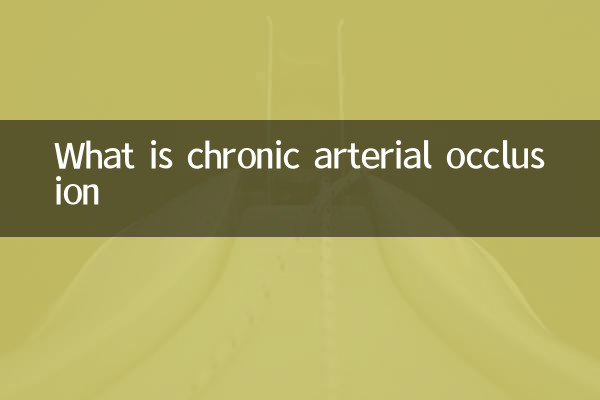What is chronic arterial occlusion
Chronic arterial occlusion is a common vascular disease, which mainly refers to the pathological state in which the arterial lumen is gradually narrowed or even completely blocked due to atherosclerosis, thrombosis or other reasons, thus affecting the blood supply. The disease mostly occurs in the arteries of the lower limbs, but can also occur in the arteries of important organs such as the heart, brain, and kidneys. Without timely intervention, serious consequences such as tissue ischemia, necrosis or even amputation may result.
1. Causes and risk factors of chronic arterial occlusion

The main cause of chronic arterial occlusion is atherosclerosis, but other factors include thrombosis, vasculitis, or trauma. The following are common risk factors:
| risk factors | Description |
|---|---|
| high blood pressure | Long-term hypertension can damage the vascular endothelium and accelerate arteriosclerosis. |
| Hyperlipidemia | Cholesterol deposits form plaque, causing blood vessels to narrow. |
| diabetes | Poor blood sugar control can damage blood vessel walls and increase the risk of occlusion. |
| smoking | Harmful substances such as nicotine directly damage the vascular endothelium. |
| age | The incidence rate has increased significantly among people over 50 years old. |
2. Typical symptoms of chronic arterial occlusion
Symptoms vary depending on the location and degree of occlusion. The following is a classification of common symptoms:
| symptom stage | clinical manifestations |
|---|---|
| Early days | Intermittent claudication (limb pain when walking, relieved by rest) |
| medium term | Rest pain (persistent pain in limbs at night) |
| Late stage | Skin ulcers, gangrene, and even the need for amputation |
3. Diagnosis and examination methods
The diagnosis of chronic arterial occlusion requires a combination of clinical manifestations and imaging examinations. The following are commonly used examination methods:
| Check method | function |
|---|---|
| Ankle-brachial index (ABI) | Assessing the degree of lower limb ischemia by blood pressure ratio |
| Ultrasound Doppler | Non-invasive detection of blood flow velocity and vascular stenosis |
| CT Angiography (CTA) | Clearly display the three-dimensional structure of blood vessels and locate the occlusion site |
| Magnetic resonance angiography (MRA) | No radiation, suitable for patients with renal insufficiency |
4. Treatment and preventive measures
Treatment of chronic arterial occlusion requires an individualized plan based on the severity of the condition:
| Treatment | Specific measures |
|---|---|
| drug treatment | Antiplatelet (aspirin), lipid-lowering (statins), vasodilator drugs |
| interventional therapy | Minimally invasive surgeries such as balloon dilation and stent implantation |
| surgery | Bypass or endarterectomy |
| lifestyle intervention | Quit smoking, control blood sugar and blood pressure, and exercise moderately |
5. Relevant hot topics in the past 10 days
The following is the hot content related to chronic arterial occlusion that the entire Internet has recently paid attention to:
| hot topics | Summary of contents |
|---|---|
| New drug-coated stent | Studies show significant reduction in restenosis rates |
| Stem cell therapy progress | Clinical trials have shown that it can promote the establishment of collateral circulation |
| Artificial Intelligence Assisted Diagnosis | Deep learning algorithm improves CTA image analysis efficiency |
| Remote monitoring technology | Wearable device tracks blood flow in patients' lower limbs in real time |
Chronic arterial occlusion is a chronic disease that requires long-term management. Early detection and standardized treatment can significantly improve the prognosis. Patients should follow up regularly, actively cooperate with doctors to formulate treatment plans, and maintain a healthy lifestyle to reduce the risk of complications.

check the details

check the details